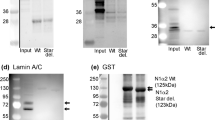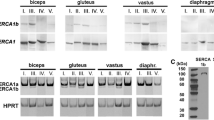Summary
The expression of myosin heavy chain isoforms in muscle spindle fibres has been the subject of a number of immunocytochemical studies, some of them with discordant results. In order to assess whether these discrepancies are due to differences in the specificity and sensitivity of the antibodies used, we have compared the reactivity of rat muscle spindle fibres to two pairs of antibodies presumed to be directed against slow tonic (ALD 19 and ALD 58) and neonatal (NN5) and neonatal/fast (MF30) myosin heavy chains. Adult, developing and neonatally de-efferented muscle spindles from the rat hind limb muscles were studied in serial cross-sections processed for the peroxidase-antiperoxidase method. Important differences in the staining profiles of intrafusal fibres were noted when ALD 19 and ALD 58 were compared. ALD 19 stained the muscle spindle precursors from the seventeenth day in utero, whereas ALD 58 only did so by the twentieth day of gestation. In adult spindles ALD 19 stained the nuclear bag1 fibres along their entire length, whereas ALD 58 did not stain these fibres towards their ends. ALD 19 stained the nuclear bag2 fibres along the A, B and inner C region, but ALD 58 stained these fibres only in the A and the inner B regions. ALD 19 stained some nuclear chain fibres along a short equatorial segment, whereas ALD 58 did not stain the nuclear chain fibres at all. NN5 stained the nascent nuclear bag1 and chain fibre precursors at earlier stages of development than MF30. Clear differential staining between primary and secondary generation of both extra- and intrafusal myotubes was seen with NN5, wheras MF30 stained all myotubes alike. However, in postnatal spindles, MF30 was a very good negative marker of nuclear bag1 fibres. The staining profile of the adult fibres with NN5 and MF30 was rather similar. The staining pattern of neonatally de-efferented bag fibres obtained with ALD 19 and ALD 58 was practically identical and it differed from that of control spindles, confirming that motor innervation participates in the regulation of the expression of slow tonic MHC along the length of the nuclear bag2 fibres, as we have previously shown with ALD 19. The distinct staining patterns obtained with ALD 19 versus ALD 58 and with NN5 versus MF30 reflect differences in antibody sensitivity and specificity. These differences account, in part, for the discrepancies in the results of previous studies on muscle spindles, published by Kucera and Walro using ALD 58 and MF30, and by us using ALD 19 and NN5.
Similar content being viewed by others
References
Bader D, Masaki T, Fischman DA (1982) Immunochemical analysis of myosin heavy chain during avian myogenesis in vivo and in vitro. J Cell Biol 95:763–770
Bär A, Pette D (1988) Three fast myosin heavy chains in adult rat skeletal muscle. FEBS Lett 235:153–155
Barker D, Banks RW (1986) The muscle spindle. In: Engel AG, Banker BQ (eds) Myology, McGraw-Hill, New York, pp 309–341
Boyd IA (1985) Muscle spindles and stretch reflexes. In: Swash M, Kennard C (eds) Scientific basis of clinical neurology. Churchill Livingstone, Edinburgh London, pp 74–97
Butler-Browne GS, Whalen RG (1984) Myosin isozyme transitions occuring during the postnatal development of the rat soleus muscle. Dev Biol 102:324–334
Condon K, Silberstein L, Blau HM, Thompson WJ (1990) Development of muscle fiber types in the prenatal rat hindlimb. Dev Biol 138:256–274
Dhoot GK (1986) Selective synthesis and degradation of slow skeletal myosin heavy chains in developing muscle fibers. Muscle Nerve 9:155–164
Draeger A, Weeds AG, Fitzsimons RB (1987) Primary, secondary and tertiary myotubes in developing skeletal muscle: a new approach to the analysis of human myogenesis. J Neurol Sci 81:19–43
Dubowitz V, Brooke MH (1973) Muscle biopsy: a modern approach. WB Saunders, London
Ecob-Prince M, Hill M, Brown W (1989) Immunocytochemical demonstration of myosin heavy chain expression in human muscle. J Neurol Sci 91:71–78
Eriksson PO, Butler-Browne GS, Fischman DA, Grove BK, Schiaffino S, Virtanen I, Thornell L-E (1988) Myofibrillar and cytoskeletal proteins in human muscle spindles. In: Hník P, Soukup T, Vejsada R, Zelená J (eds) Mechanoreceptors — development, structure and function. Plenum Press, New York, pp 273–274
Fei C, Walro JM (1989) The re-expression of two myosin heavy chains in regenerated rat muscle spindles. Neurosci Lett 97:75–79
Gauthier GF, Lowey S, Hobbs AW (1978) Fast and slow myosin in developing muscle fibers. Nature 274:25–29
Gorza L (1990) Identification of a novel type 2 fiber population in mammalian skeletal muscle by combined use of histochemical myosin ATPase and anti-myosin monoclonal antibodies. J Histochem Cytochem 38:257–265
Harris AJ, Fitzsimons RB, McEwan JC (1989) Neural control of the sequence of expression of myosin heavy chain isoforms in foetal mammalian muscles. Development 107:751–769
Kronnie G te, Donselaar Y, Soukup T, Raamsdonk W van (1981) Immunohistochemical differences in myosin composition among intrafusal muscle fibres. Histochemistry 73:65–74
Kronnie G te, Donselaar Y, Soukup T, Zelená J (1982) Development of immunohistochemical characteristics of intrafusal fibers in normal and de-efferented rat muscle spindles. Histochemistry 74:355–366
Kucera J, Walro JM (1987) Postnatal maturation of spindles in deafferented rat soleus muscles. Anat Embryol 176:449–461
Kucera J, Walro JM (1988) The effect of neonatal deafferentation or deefferentation on myosin heavy chain expression in intrafusal muscle fibres of the rat. Histochemistry 90:151–160
Kucera J, Walro JM (1989) Postnatal expression of myosin heavy chains in muscle spindles of the rat. Anat Embryol 179:369–376
Kucera J, Walro J (1990a) Myosin heavy chain expression in developing rat intrafusal muscle fibres. Neurosci Lett 109:18–22
Kucera J, Walro JM (1990b) Origin of intrafusal muscle fibres in the rat. Histochemistry 93:567–580
Kucera J, Walro JM (1990c) Treatment with β bungarotoxin blocks muscle spindle formation in fetal rats. Development 110:483–489
Kucera J, Walro JM, Reichler J (1989) Role of nerve and muscle factors in the development of rat muscle spindles. Am J Anat 186:144–160
Maier A, Gambke B, Pette D (1988) Immunohistochemical demonstration of embryonic myosin heavy chains in adult mammalian intrafusal fibres. Histochemistry 88:267–271
Narusawa M, Fitzsimons RB, Izumo S, Nadal-Ginard B, Rubinstein NA, Kelly AM (1987) Slow myosin in developing rat skeletal muscle. J Cell Biol 104:447–459
Pedrosa F, Butler-Browne GS, Dhoot GK, Fischman DA, Thornell L-E (1989) Diversity in expression of myosin heavy chain isoforms and M band proteins in rat muscle spindles. Histochemistry 92:185–194
Pedrosa F, Soukup T, Thornell L-E (1990) Expression of an alpha cardiac-like myosin heavy chain in muscle spindle fibres. Histochemistry 95:105–113
Pedrosa F, Thornell L-E (1990) Expression of myosin heavy chain isoforms in developing rat muscle spindles. Histochemistry 94:231–244
Pette D, Staron RS (1990) Cellular and molecular diversities of mammalian skeletal muscle fibres. Rev Physiol Biochem Pharmacol 116:1–76
Pierobon-Bormioli S, Sartore S, Vitadello M, Schiaffino S (1980) “Slow” myosins in vertebrate skeletal muscle. An immunofluorescence study. J Cell Biol 85:672–681
Rowlerson A, Gorza L, Schiaffino S (1985) Immunohistochemical identification of spindle fibre types in mammalian muscle using type-specific antibodies to isoforms of myosin. In: Boyd IA, Gladden MH (eds) The muscle spindle. MacMillan Press, London, pp 29–34
Rubinstein NA, Kelly AM (1981) Development of muscle fiber specialization in the rat hindlimb. J Cell Biol 90:128–144
Sawchak J, Leung B, Shafiq SA (1985) Characterization of a monoclonal antibody to myosin specific for mammalian and human type II muscle fibres. J Neurol Sci 69:247–254
Schafiq SA, Shimizu T, Fischman DA (1984) Heterogeneity of type I skeletal muscle fibres revealed by monoclonal antibody to slow myosin. Muscle Nerve 7:380–387
Schiaffino S, Gorza L, Sartore S, Saggin L, Ausoni S, Vianello M, Gundersen K, Lomo T (1989) Three myosin heavy chain isoforms in type 2 skeletal muscle fibres. J Muscle Res Cell Motil 10:197–205
Soukup T (1976) Intrafusal fibre types in rat limb muscle spindles. Morphological and histochemical characteristics. Histochemistry 47:43–57
Soukup T, Pedrosa F, Thornell L-E (1990a) Influence of neonatal motor denervation on expression of myosin heavy chain isoforms in rat muscle spindles. Histochemistry 94:245–256
Soukup T, Pedrosa F, Thornell L-E (1990b) Rat intrafusal fibres regenerated after autotransplantation of the EDL muscle do not express their typical myosin heavy chain isoenzymes in the absence of sensory innervation. In: Marechal G, Carraro U (eds) Muscle and motility. Intercept, Andover, Hampshire, pp 105–110
Termin A, Staron RS, Pette D (1989) Myosin heavy chain isoforms in histochemically defined fiber types of rat muscle. Histochemistry 92:453–457
Thornell L-E, Eriksson PO, Fischman DA, Grove BK, Butler-Browne GS, Virtanen I (1988) Human muscle spindle development. In: Hník P, Soukup T, Vejsada R, Zelená J (eds) Mechanoreceptors: development, structure and function. Plenum Press, New York, pp 39–44
Thornell L-E, Grove BK, Pedrosa F, Butler-Browne GS, Dhoot GK, Fischman DA (1989) Expression of slow tonic myosin in muscle spindle fibres early in mammalian development. Cellular and molecular biology of muscle development. In: Stockdale FE, Kedes LH (eds) UCLA Symposia on Molecular and Cellular Biology, vol. 93. Alan R. Liss, New York, pp 471–480
Whalen RG, Sell SM, Butler-Browne GS, Schwartz K, Bouveret P, Pinset-Härström I (1981) Three myosin heavy-chain isozymes appear sequentially in rat muscle development. Nature 292:805–809
Zelená J (1957) The morphogenetic influence of innervation on the ontogenetic development of muscle spindles. J Embryol Exp Morphol 5:283–292
Zelená J (1976) The role of sensory innervation in the development of mechanoreceptors. Prog Brain Res 43:69–74
Zelená J, Soukup T (1973) Development of muscle spindles deprived of fusimotor innervation. Z Zellforsch 144:435–452
Zelená J, Soukup T (1974) The differentiation of intrafusal fibre types in rat muscle spindles after motor denervation. Cell Tissue Res 153:115–136
Author information
Authors and Affiliations
Rights and permissions
About this article
Cite this article
Pedrosa-Domellöf, F., Soukup, T. & Thornell, LE. Rat muscle spindle immunocytochemistry revisited. Histochemistry 96, 327–338 (1991). https://doi.org/10.1007/BF00271354
Received:
Accepted:
Issue Date:
DOI: https://doi.org/10.1007/BF00271354




